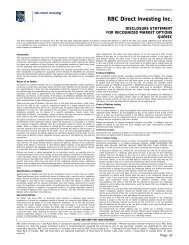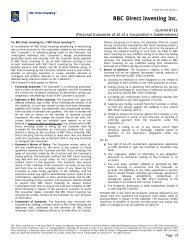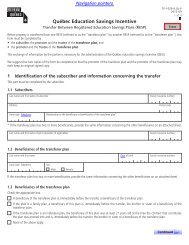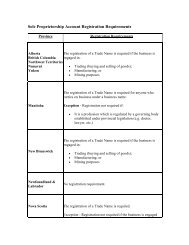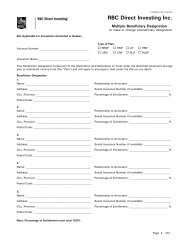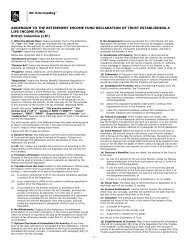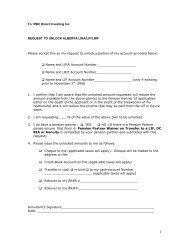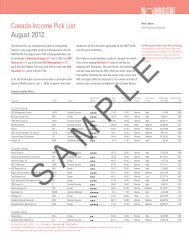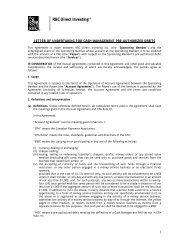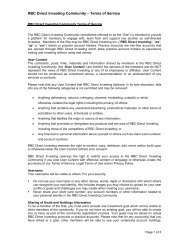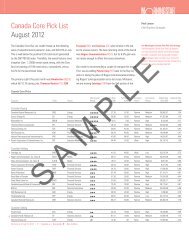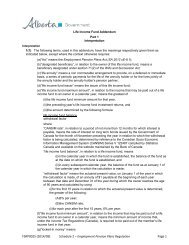View Sample PDF - RBC Direct Investing
View Sample PDF - RBC Direct Investing
View Sample PDF - RBC Direct Investing
Create successful ePaper yourself
Turn your PDF publications into a flip-book with our unique Google optimized e-Paper software.
Regional Outlook – Emerging Markets<br />
Philippe Langham<br />
Senior Portfolio Manager<br />
<strong>RBC</strong> Asset Management UK Limited<br />
Risk aversion returned to markets this<br />
quarter with a renewed focus on the<br />
sovereign-debt crisis in Europe and<br />
its impact on fragile global economic<br />
growth. This has led to a sharp selloff<br />
in emerging-market stocks, as<br />
well as in other risk assets. In this<br />
environment, the high correlation<br />
among global stock markets has<br />
been evident.<br />
The current public-debt stresses in<br />
the developed world are a reminder<br />
of why it makes sense in the long run<br />
to maintain significant exposure to<br />
the much healthier economic growth<br />
found in emerging markets. Growth in<br />
the developed world will continue to<br />
be constrained by high government<br />
debt and private-sector deleveraging.<br />
While emerging economies will not<br />
be immune to weaker global growth<br />
driven by the deleveraging, their rates<br />
of growth are likely to continue to be<br />
significantly higher than those of their<br />
developed-world counterparts because<br />
they do not face the same debt<br />
overhang.<br />
Inflation in developing markets has<br />
begun to fall, as food prices have come<br />
down and global growth has slowed.<br />
Given the improving inflation data,<br />
most emerging-market central banks<br />
have begun monetary-easing cycles.<br />
This is a clear positive for emergingmarket<br />
assets, which suffered for<br />
much of last year on concerns over<br />
inflation and the associated restrictive<br />
monetary policies. Looking ahead,<br />
there is a strong case to be made that<br />
food prices will continue to decline<br />
over the next year given a high level of<br />
Emerging Market Datastream Index Equilibrium<br />
Normalized Earnings and Valuations<br />
513<br />
394<br />
303<br />
Jun. '12 Range: 205 - 364 (Mid: 285)<br />
Jun. '13 Range: 219 - 389 (Mid: 304)<br />
Current (01-June-12): 231<br />
233<br />
179<br />
137<br />
106<br />
81<br />
62<br />
48<br />
1995 2000 2005 2010 2015<br />
Source: Datastream, <strong>RBC</strong> GAM<br />
long speculative positions and strong<br />
global growth in arable acreage. The<br />
one market where there has been<br />
some investor disappointment with<br />
monetary easing is China. This reflects<br />
the leadership’s view that the massive<br />
post-Lehman surge in credit was a<br />
mistake. It also reflects their view that<br />
growth in China can be maintained<br />
without the need for aggressive<br />
stimulus. Since the EU accounts for<br />
a large portion of China’s exports,<br />
an even larger slowdown in demand<br />
would likely prompt Chinese officials to<br />
become more aggressive in stimulating<br />
the economy.<br />
The valuation case for emerging<br />
markets has become more attractive<br />
in the past 12 months. Based on<br />
consensus 2012 earnings, the forward<br />
P/E ratio is under 10 and well below its<br />
long-run average. On a price-to-bookvalue<br />
basis, emerging-market equities<br />
also trade at a significant discount<br />
to history and at a level that has<br />
historically portended strong 12-month<br />
performance. In addition, widening<br />
spreads between emerging-market<br />
earnings yields and bond yields since<br />
2010 are incongruent with current<br />
market conditions, so we expect these<br />
yields to converge over time via an<br />
uptick in equity prices. The valuation<br />
discount to developed markets has<br />
also widened following a degree of<br />
underperformance over the past year,<br />
and now stands at 15%.<br />
In terms of positioning, our long-term<br />
top-down bias for domestic sectors<br />
and quality, and away from cyclical<br />
areas and commodities, makes even<br />
more sense in the current environment.<br />
Equity markets are likely to follow<br />
credit markets in distinguishing<br />
between good and bad credit. In this<br />
environment, companies with strong<br />
balance sheets, robust free-cash-flow<br />
generation and high returns on capital<br />
are likely to outperform. Furthermore,<br />
as global growth slows, companies<br />
that are able to deliver good growth<br />
will enable their stocks to command<br />
SAMPLE<br />
62 I The global investment outlook <strong>RBC</strong> INVESTMENT Strategy coMMITTEE Summer 2012



